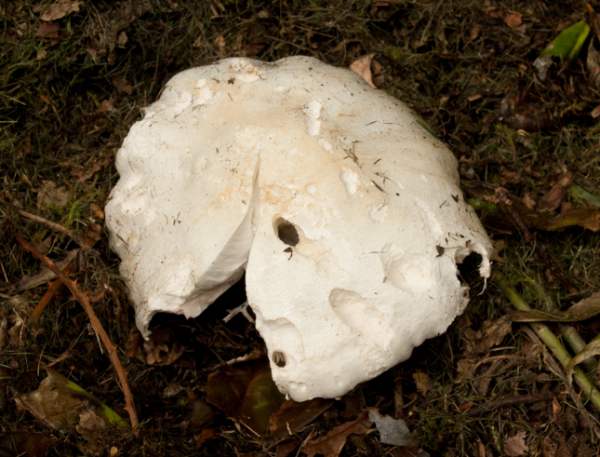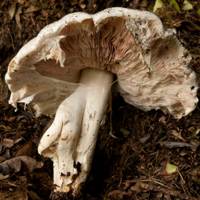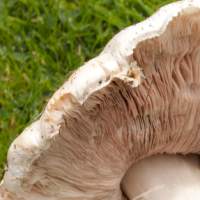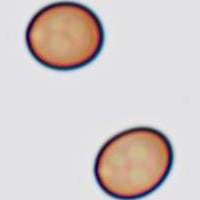Trees Birds Mammals Fish Amphibians Reptiles
Wild Algarve
Bookshop
Agaricus osecanus Pilát - Snowy Mushroom
Phylum: Basidiomycota - Class: Agaricomycetes - Order: Agaricales - Family: Agaricaceae
Distribution - Taxonomic History - Etymology - Identification - Culinary Notes - Reference Sources

Agaricus osecanus is a close relative of the Horse Mushroom Agaricus arvensis; however, it differs in several significant respects, including its snowy white colouring and the lack of a strong aniseed odour even when fully mature. Other differences are detailed in the Identification section, below.
Distribution
Agaricus osecanus is quite rare in Britain and Ireland; it can also be found in mainland European countries and eastern parts of North America.
Taxonomic history
Another claimant to the title 'thoroughly modern mushroom', this species was described scientifically in 1951 by Czech mycologist Albert Pilát (1903 - 1974) and given the binomial scientific name Agaricus osecanus.
Valid synonyms of Agaricus osecanus include Agaricus nivescens (F.H. Møller) F.H. Møller, Agaricus nivescens var. parkensis (F.H. Møller) F.H. Møller, Psalliota nivescens F.H. Møller, and Psalliota nivescens var. parkensis F.H. Møller.
Etymology
The Latin adjective canus means white (but is also used to describe something as foamy or hairy), while the prefix os- (with an 'e' appended for ease of pronumciation, perhaps) means bone. (But os can also mean face, mouth or expression.) It seems most likely, therefore, that osecanus is intended to imply 'white like a bone' or 'bone white' as this is indeed the dominant colour of caps of Agaricus osecanus. My thanks to Corina Marcos and her family for this suggestion.
Identification guide
 |
Cap
Initially globose, the
cap of Agaricus urinascens expands to become plano convex and eventually flattens without an in-rolled margin, and the surface is radially fibrillose or scaly at maturity, white at first but becoming pale ochre and yellowing slightly, especially near the margin, when bruised.
Caps grow to between 10
and 25cm diameter at maturity. The cap flesh is creamy white and the upper surface has a whitish background covered in grey-brown scales, densest and darkest towards the centre. When bruised, the cap surface turns yellow, most noticeably towards the margin. |
 |
Gills
Pale greyish pink when young, the crowded free somewhat irregularly undulating gills later become dark brown or purplish brown as the fruitbody ages. The gill edges are slightly paler than the gill faces.
The cheilocystidia are fusiform.
Stem
The stem is 2 to 3.5cm in diameter and 7 to 12 cm long, cylindrical with a pendent membranous ring, the lower surface patterned like a cog wheel. Above the ring the stem surface is smooth, while below it is scaly. When cut the stem flesh turns slightly pinkish at the stem base. |
 |
Basidia
Nearly all four-spored.
Spores
Ellipsoidal, smooth, thick-walled. 6-7 x 5-5.5µm with typically four oil drops.
Spore print
Brown. |
Odour/taste |
Odour faint, of crushed almonds; taste mild, 'mushroomy'. |
Habitat & Ecological role |
Agaricus osecanus is saprobic and occurs in permanent pastures and parkland and on grassy roadside verges. |
Season |
Early July to late October in Britain and Ireland. |
Similar species |
Agaricus arvensis, the Horse Mushroom, initially has a similar white cap but at maturity it takes on a more yellowish hue.
Immature fruitbodies of the Yellow Stainer Agaricus xanthodermus are similar but have a flat central area rather than the domed top of Agaricus osecanus. |
Culinary Notes
Agaricus osecanus is a good edible species and can be used in any recipe calling for large cultivated (Portobello) mushrooms. It is great in risotto dishes and omelettes, and it makes tasty soups and sauces to be served with meat.
Reference Sources
Fascinated by Fungi, 2nd Edition, Pat O'Reilly 2016, reprinted by Coch-y-bonddu Books in 2022.
BMS List of English Names for Fungi
The genus Agaricus in Britain, 3rd Edition, self-published, Geoffrey Kibby 2011
Funga Nordica: 2nd edition 2012. Edited by Knudsen, H. & Vesterholt, J. ISBN 9788798396130
Dictionary of the Fungi; Paul M. Kirk, Paul F. Cannon, David W. Minter and J. A. Stalpers; CABI, 2008
Taxonomic history and synonym information on these pages is drawn from many sources but in particular from the British Mycological Society's GB Checklist of Fungi.
Acknowledgements
This page includes pictures kindly contributed by David Kelly.
Top of page...
Fascinated by Fungi. Back by popular demand, Pat O'Reilly's best-selling 450-page hardback book is available now. The latest second edition was republished with a sparkling new cover design in September 2022 by Coch-y-Bonddu Books. Full details and copies are available from the publisher's online bookshop...